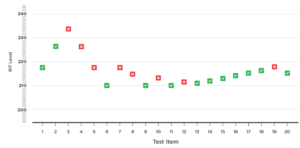Children learn better—and faster—when teachers have a clear picture of what students know and how they are growing academically. That’s why a group of educators and researchers founded NWEA®, a not-for-profit organization that has created some of the most trusted and reliable assessment solutions available. More than 13 million students in the US and in 140 countries worldwide use MAP® Growth™.
How it works
MAP Growth is a computer-adaptive test. If your child answers a question correctly, the next question is more challenging. If they answer incorrectly, the next one is easier. This type of assessment challenges top performers without overwhelming students whose skills are below grade level.
MAP Growth begins with a question at each student’s grade level and adjusts the level of difficulty based on individual performance.

What it measures
MAP Growth uses a RIT scale to accurately measure what students know, regardless of their grade level. It also measures growth over time, allowing you to track your child’s progress throughout the school year and across multiple years. Once your child completes a MAP Growth test, they receive a RIT score.
The RIT scale precisely measures student performance, regardless of whether they’re performing on, above, or below grade level.

Your child's RIT score
RIT scores have the same meaning across grade levels. If a fourth-grade student and an eighth-grade student have the same RIT score in reading, then they are testing at the same level in that subject. This stable scale allows teachers to accurately measure each student’s academic growth throughout the school year and over time.
You can use your child’s RIT score to help them meet their goals. For example, students can enter their RIT scores into our college explorer tool to see which colleges and universities they’re on track to enter. You can also ask your child’s school about educational resources that use MAP Growth RIT scores to provide personalized learning resources.

Common Questions
How do schools and teachers use MAP Growth scores?
Teachers can use the scores to identify learning areas that their class should focus on, as well as monitor the growth of individual students. Principals and administrators can use the scores to see the performance and progress of a grade level, school, or the entire district.
Can MAP Growth tell me if my child is working at grade level?
Yes, but please note that MAP Growth scores are just one data point that teachers use todetermine how a student is performing. Please discuss any questions that you have aboutyour child’s performance with their teacher.
How often will my child take MAP Growth tests?
Most schools give MAP Growth tests to students at the beginning, middle, and end of the school year (in the fall, winter, and spring). Some schools choose to administer tests only twice a year.
What are norms?
NWEA provides schools with norms by utilizing anonymous data from more than 10 million students around the US. Knowing the top, middle, and bottom scores of all these students combined allows teachers to compare where your child is to other students and help them grow. In addition, NWEA provides comparison data for private, accredited, English-based, international schools using MAP Growth outside the US.
Is MAP Growth a standardized test?
MAP Growth is administered periodically during the school year. Instead of asking all students the same questions, it adjusts to each child’s performance—giving a more accurate measure of what they know. Teachers also receive results right away, which enables them to react more quickly.
What types of questions are on MAP Growth tests?
The MAP Growth tests include multiple choice, drag-and-drop, and other types of questions. For sample tests, visit Warmup.NWEA.org.
 Contact
Contact  Calendars
Calendars Careers
Careers Engage
Engage  District
District
